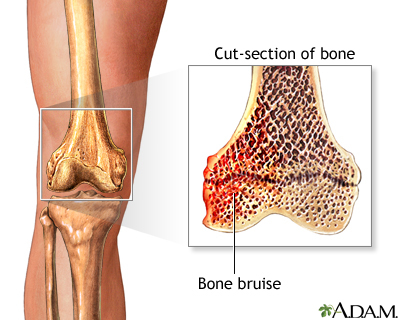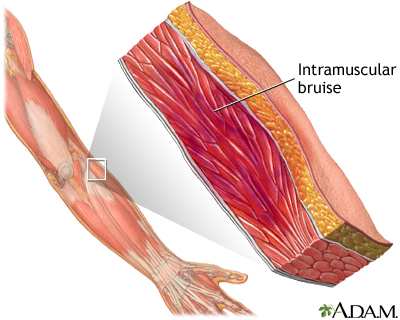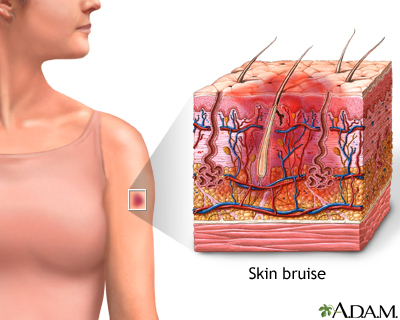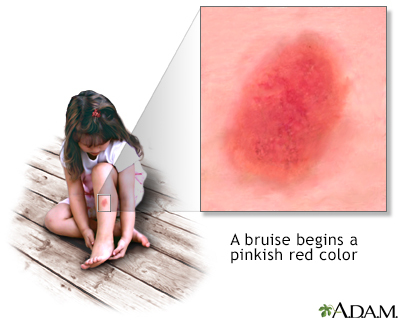Courtney and the Cancer She Never Planned For
Courtney has always been a planner, even as a child. Growing up in Gainesville, she produced pretend weddings for her sister and neighborhood friends, ensuring…

Update your location to show providers, locations, and services closest to you.
A bruise is an area of skin discoloration. A bruise occurs when small blood vessels break and leak their contents into the soft tissue beneath the skin.
Contusion; Hematoma
There are three types of bruises:
Bruises can last from days to months. A bone bruise is the most severe and painful.
Bruises are often caused by falls, sports injuries, car accidents, or blows received from other people or objects.
If you take a blood thinner, such as aspirin, warfarin (Coumadin, Jantoven), dabigatran (Pradaxa), rivaroxaban (Xarelto), apixaban (Eliquis), or clopidogrel (Plavix), you are likely to bruise more easily.
Main symptoms are pain, swelling, and skin discoloration. The bruise begins as a pinkish red color that can be very tender to touch. It is often difficult to use the muscle that has been bruised. For example, a deep thigh bruise is painful when you walk or run.
Eventually, the bruise changes to a bluish color, then greenish-yellow, and finally returns to the normal skin color as it heals.
In the rare case of compartment syndrome, surgery is often done to relieve the extreme buildup of pressure. Compartment syndrome results from increased pressure on the soft tissues and structures beneath the skin. It can decrease the supply of blood and oxygen to the tissues.
Call your health care provider right away if you feel extreme pressure in a bruised part of your body, especially if the area is large or very painful. This may be due to compartment syndrome, and can be life-threatening. You should receive emergency care.
Also call your provider if:
Because bruises are usually the direct result of an injury, the following are important safety recommendations:




Buttaravoli PM, Leffler S, Herrington RR. Contusion: (bruise). In: Buttaravoli PM, Leffler S, Herrington RR, eds. Minor Emergencies. 4th ed. Philadelphia, PA: Elsevier; 2022:chap 134.
Cameron P, O'Reilly G. Trauma overview. In: Cameron P, Little M, Mitra B, Deasy C, eds. Textbook of Adult Emergency Medicine. 5th ed. Philadelphia, PA: Elsevier; 2020:67-71.
Hayward CPM. Clinical approach to the patient with bleeding or bruising. In: Hoffman R, Benz EJ, Silberstein LE, et al, eds. Hematology: Basic Principles and Practice. 7th ed. Philadelphia, PA: Elsevier; 2018:chap 128.
Moyes C, Blessing K. Skin. In: Simon S. Cross SS, ed. Underwood's Pathology. 7th ed. Philadelphia, PA: Elsevier; 2019:chap 24.
Courtney has always been a planner, even as a child. Growing up in Gainesville, she produced pretend weddings for her sister and neighborhood friends, ensuring…

Popular micromobility devices such as electronic bikes and scooters, all-terrain vehicles or ATVs, hoverboards and even the childhood favorite, roller skates,…

Would you invest about 11 minutes a day to reduce the risk of an early death? It’s no longer an abstract question, now that researchers in England have determined that a brisk, daily walk...
The fast walkers of the world apparently have a leg up on the tortoises among us. Physicians have long known that one of the best tools to good health doesn’t involve fancy schmancy exercise...
Slowpokes, beware. A lack of speed on the daily walk might be putting you on the road to a shorter life. A study by British researchers analyzing the lives of nearly a half-million people found...